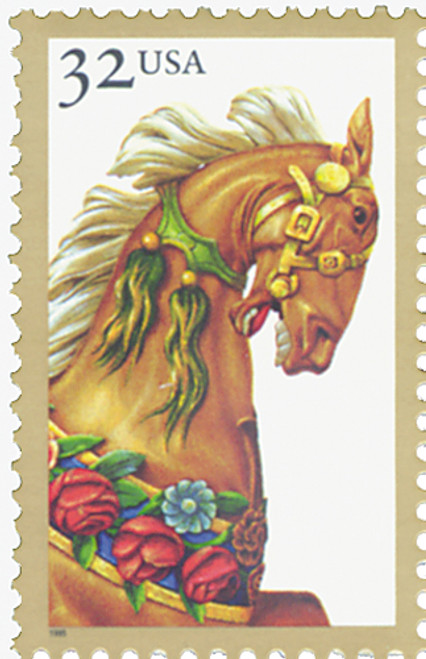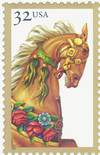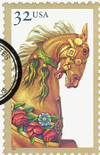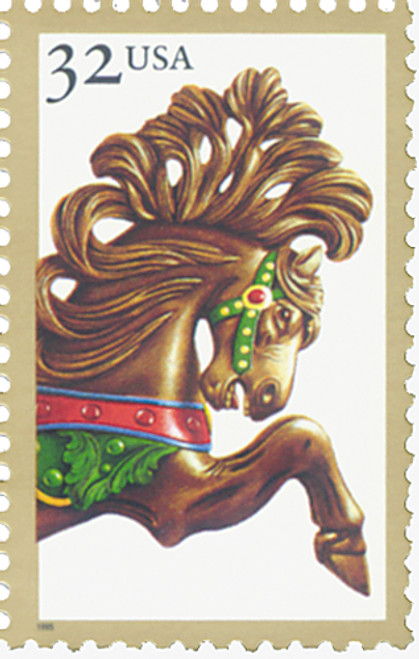
# 2976 - 1995 32c Carousel Horses: Palamino Pony
U.S. #2976
1995 Palamino Carousel Horse
- This stamp is part of the American Folk Art Series
- It’s the second issuance of carousel animals
- Metallic gold ink borders each stamp
Stamp Category: Commemorative
Set: Carousel Horse
Value: 32¢
First Day of Issue: July 21, 1995
First Day City: Lahaska, PA
Quantity Issued: 3,125,000
Printed by: Ashton-Potter
Printing Method: Offset 160 subjects (10 across, 16 down)
Format: Panes of 20, vertical – 5 across and 4 down.
Perforations: 11.1
Why the stamp was issued: This stamp was issued due to the previous success of the 1988 carousel animals stamps issued as part of the American Folk Art Series.
About the stamp design: Paul Calle had designed the previous 1988 carousel animal stamps and was asked again to design the carousel horses. He used two carousel picture books as resources to his designs. The golden “lead” horse pictured on the stamp is from around 1910 in the Coney Island Style. It was decorated with gold and silver leaf and adorned with ribbons, tassels, and flowers. This particular horse was one of the largest horses ever carved.
Special design details: Ashton-Potter added microprinting into the design, but the Postal Service thought the phosphored paper and the metallic gold ink would discourage counterfeits. Also, poles to indicate carousel animals were left off the 1995 issues, while included in the 1988 issues because it was felt they were unnecessary.
About the printing process: Stamps were actually printed by a sub-contractor hired by Ashton-Potter. The company was Sterling Sommer located in Tonawanda, NY. They used an Akiyama 628 6-color sheetfed offset-press.
First Day City: The first-day ceremony was held at the Carousel World Museum in Lahaska, Pennsylvania, due to a suggestion made by Paul Calle. The golden lead horse, the black Indian horse, and the high-mane pony illustrated in #2976, #2977, and #2979 respectively, that Calle used as a reference, were present for the ceremony. Charlotte Dinger owner of the three horses brought them to the ceremony and left them on display for a few weeks.
History the stamp represents:
Carousels have a long and fascinating history which can be traced as far back as early Byzantine times. Rather than being used for amusement however, early carousels were actually used for training purposes. In fact, the word itself comes from 12th-century Arabian games of horsemanship called carosellos or “little wars.” Fragile, heavily-scented clay balls were tossed from one rider to another; dexterity and equestrian skill were needed to avoid the unmanly mark of the loser – a bath of sweet-smelling perfume.
By the late 17th century, carousels had been developed to train young noblemen for spearing contests. Seated on wooden horses the riders tried to lance rings as they rode around a pole. Forerunner of the modern-day carousel and its game of “catching the brass ring,” the ride evolved into a popular form of entertainment.
The King Horse, pictured on this stamp, with its fancy tassels and cabbage roses, is typical of the Coney Island style carousel horse. One of the largest horses ever created, this dramatic steed was carved by Stein and Goldstein around 1910.
U.S. #2976
1995 Palamino Carousel Horse
- This stamp is part of the American Folk Art Series
- It’s the second issuance of carousel animals
- Metallic gold ink borders each stamp
Stamp Category: Commemorative
Set: Carousel Horse
Value: 32¢
First Day of Issue: July 21, 1995
First Day City: Lahaska, PA
Quantity Issued: 3,125,000
Printed by: Ashton-Potter
Printing Method: Offset 160 subjects (10 across, 16 down)
Format: Panes of 20, vertical – 5 across and 4 down.
Perforations: 11.1
Why the stamp was issued: This stamp was issued due to the previous success of the 1988 carousel animals stamps issued as part of the American Folk Art Series.
About the stamp design: Paul Calle had designed the previous 1988 carousel animal stamps and was asked again to design the carousel horses. He used two carousel picture books as resources to his designs. The golden “lead” horse pictured on the stamp is from around 1910 in the Coney Island Style. It was decorated with gold and silver leaf and adorned with ribbons, tassels, and flowers. This particular horse was one of the largest horses ever carved.
Special design details: Ashton-Potter added microprinting into the design, but the Postal Service thought the phosphored paper and the metallic gold ink would discourage counterfeits. Also, poles to indicate carousel animals were left off the 1995 issues, while included in the 1988 issues because it was felt they were unnecessary.
About the printing process: Stamps were actually printed by a sub-contractor hired by Ashton-Potter. The company was Sterling Sommer located in Tonawanda, NY. They used an Akiyama 628 6-color sheetfed offset-press.
First Day City: The first-day ceremony was held at the Carousel World Museum in Lahaska, Pennsylvania, due to a suggestion made by Paul Calle. The golden lead horse, the black Indian horse, and the high-mane pony illustrated in #2976, #2977, and #2979 respectively, that Calle used as a reference, were present for the ceremony. Charlotte Dinger owner of the three horses brought them to the ceremony and left them on display for a few weeks.
History the stamp represents:
Carousels have a long and fascinating history which can be traced as far back as early Byzantine times. Rather than being used for amusement however, early carousels were actually used for training purposes. In fact, the word itself comes from 12th-century Arabian games of horsemanship called carosellos or “little wars.” Fragile, heavily-scented clay balls were tossed from one rider to another; dexterity and equestrian skill were needed to avoid the unmanly mark of the loser – a bath of sweet-smelling perfume.
By the late 17th century, carousels had been developed to train young noblemen for spearing contests. Seated on wooden horses the riders tried to lance rings as they rode around a pole. Forerunner of the modern-day carousel and its game of “catching the brass ring,” the ride evolved into a popular form of entertainment.
The King Horse, pictured on this stamp, with its fancy tassels and cabbage roses, is typical of the Coney Island style carousel horse. One of the largest horses ever created, this dramatic steed was carved by Stein and Goldstein around 1910.












